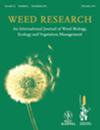Ecological determinants and risk areas of Striga hermonthica infestation in western Kenya under changing climate
IF 2.2
3区 农林科学
Q2 AGRONOMY
引用次数: 0
Abstract
Striga hermonthica (Del.) Benth is a parasitic weed that is damaging major cereal crops in sub-Saharan Africa (SSA). Although Striga is recognised as an agricultural scourge, there is limited information available indicating the extent of its growth and spread as impacted by the changing climate in Kenya. This study investigated the impact of current climate conditions and projected future (2050) climate change on the infestation of Striga hermonthica in the western Kenya region. Specifically, the study aimed to predict Striga hermonthica habitat suitability in five counties in the western Kenya region through using the maximum entropy (MaxEnt) model and bioclimatic, soil, topographic and land use, and land cover (LULC) variables. Striga hermonthica geolo-cations were collected and collated and ecological niche models were developed to determine the habitat suitability. The results showed that approximately 1767 km 2 (10% of the total study area) is currently highly suitable for Striga hermonthica occurrence. The future projections showed a range between 2106 km 2 (19% of the total study area) and 2712 km 2 (53% of the total study area) at the minimum carbon (RCP 2.6) and the maximum carbon emission scenarios (RCP 8.5) respectively. Elevation, annual precipitation, LULC, temperature seasonality and soil type were determined to be the most influential ecological predictor variables for Striga hermonthica establishment. The study revealed the importance of using climate, soil, topographic and LULC variables when evaluating agricultural production constraints such as Stri-ga 's prevalence. The methodology used in this study should be tested in other Striga affected areas.气候变化下肯尼亚西部褐刺虫侵染的生态决定因素和危险区
本文章由计算机程序翻译,如有差异,请以英文原文为准。
求助全文
约1分钟内获得全文
求助全文
来源期刊

Weed Research
农林科学-农艺学
CiteScore
4.30
自引率
0.00%
发文量
41
审稿时长
12-24 weeks
期刊介绍:
Weed Research is an international peer-reviewed journal that publishes topical and innovative papers on weed science, in the English language. Its aim is to publish the best weed science from around the globe and to be the journal of choice for weed science researchers. It is the official journal of the European Weed Research Society. Papers are taken on all aspects of weeds, defined as plants that impact adversely on economic, aesthetic or environmental aspects of any system. Topics include, amongst others, weed biology and control, herbicides, invasive plant species in all environments, population and spatial biology, modelling, genetics, biodiversity and parasitic plants. The journal welcomes submissions on work carried out in any part of the world.
 求助内容:
求助内容: 应助结果提醒方式:
应助结果提醒方式:


